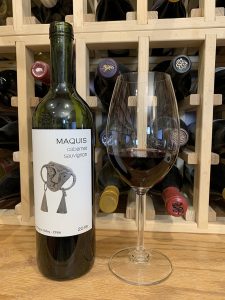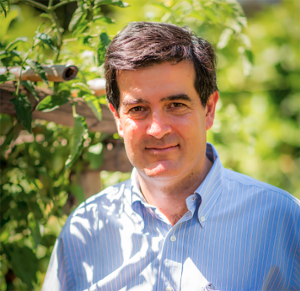Deep ruby color; black cherry, plum, leather, cinnamon, oak, flowers on the nose; black cherry, plum, blackcurrant, chocolate, coffee, oak spice on the palate.

Dry; grippy, dusty tannins with some balancing acidity (3.75 pH); benefits from decanting, which I did after first sips on pop-and-pour. Even then, wine was tight and required some swirling and more time in large glass to loosen up. But it did loosen up and evolve into wine with depth and some complexity held together by its strong tannic structure. Full body, solid wine. 14% ABV
Blend of 90% cabernet sauvignon, 6% cabernet fanc, 3% carménère, 1% petit verdot. Viña Maquis and its vineyards are located in the heart of the Colchagua Valley between the Tinguiririca River and Chimbarongo Creek. Both waterways channel cool coastal breezes and create a significant diurnal shift—a real plus for winemaking. All grapes were hand-picked and hand-sorted. Fermentation in temperature-controlled stainless steel; 21 days of maceration. Malolactic fermentation in stainless steel. Aged for one year in French oak barrels.

Viña Maqui traces its roots to the 18th century when Jesuit priests worked the vineyards. In the 19th century, two Chilean presidents used the property for cabinet meetings and built brick bridges so their ministers could attend even in rainy seasons. Remains of the bridges can still be found on the Maquis Estate.
The Hurtado family purchased the property in 1916. In 1927, their winery was one of the first buildings in Chile to be made of concrete, the vision of owner and engineer Ignacio Hurtado. In 2002, the Hurtado family built a new, modern winery to emphasize artisanal winemaking to better evoke their terroir. They are known for their cabernet franc, making them somewhat of an outlier in Chile.
Viña Maquis was among the first producers in Chile to gain sustainability certification. There is an energy recovery system based on geothermal heat pump technology. This earned the winery the 2013 Innovation Prize for energy saving and carbon footprint reduction awarded by the British-Chilean Chamber of Commerce. The vineyard has reduced its electrical consumption by 30% and its liquified gas requirements by 90%. In addition to biological corridors to host beneficial insects, birds, and animals, 2,600 sheep control weeds in winter and spring and spend every evening in the vineyard’s weaker areas to increase soil fertility.

Ricardo Rivadeneira Hurtado is the executive director and winemaker today. He trained in engineering, agronomy, and enology in London and Santiago de Chile. He refined his skills at Charles Krug in Napa Valley and Château Branaire-Ducru in France. He became general manager of Maquis in 2005 and executive director in 2019.

Rodrigo Romero is the chief winemaker. He earned a degree in agronomy at the Universidad Católica de Valparaiso and a post-graduate degree in wine production technology. After working in wineries throughout Chile, France, Italy, and Franciscan Estate Winery in Napa, Rodrigo joined Maqui in 2013.
Viña Maquis Gran Reserva Cabernet Sauvignon, Colchagua Valley, Chile 2018 delivers ripe, dark fruits. Assertive tannin and moderate acidity are brought into harmony with decanting or exposure to air in glass. The wine evolves to become balanced, soft, easy drinker. The transition from pop-and-pour to ready-to-drink is significant and worth waiting for. This will pair very well with rich cuts of beef—grilled, braised, barbecued; lamb; roast pork; pasta with meatballs and red sauce; hamburgers and comfort food in general; venison; roasted duck. Cheeses—feta, goat cheese, brie, blue cheese; this is made to stand up to very flavorful, strong cheeses. $18-22
